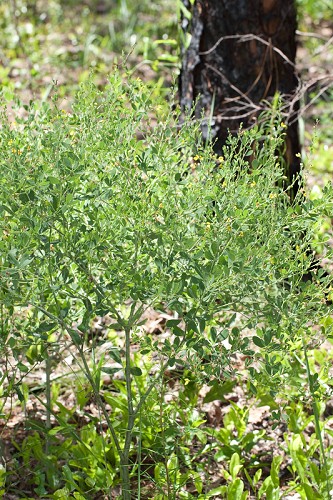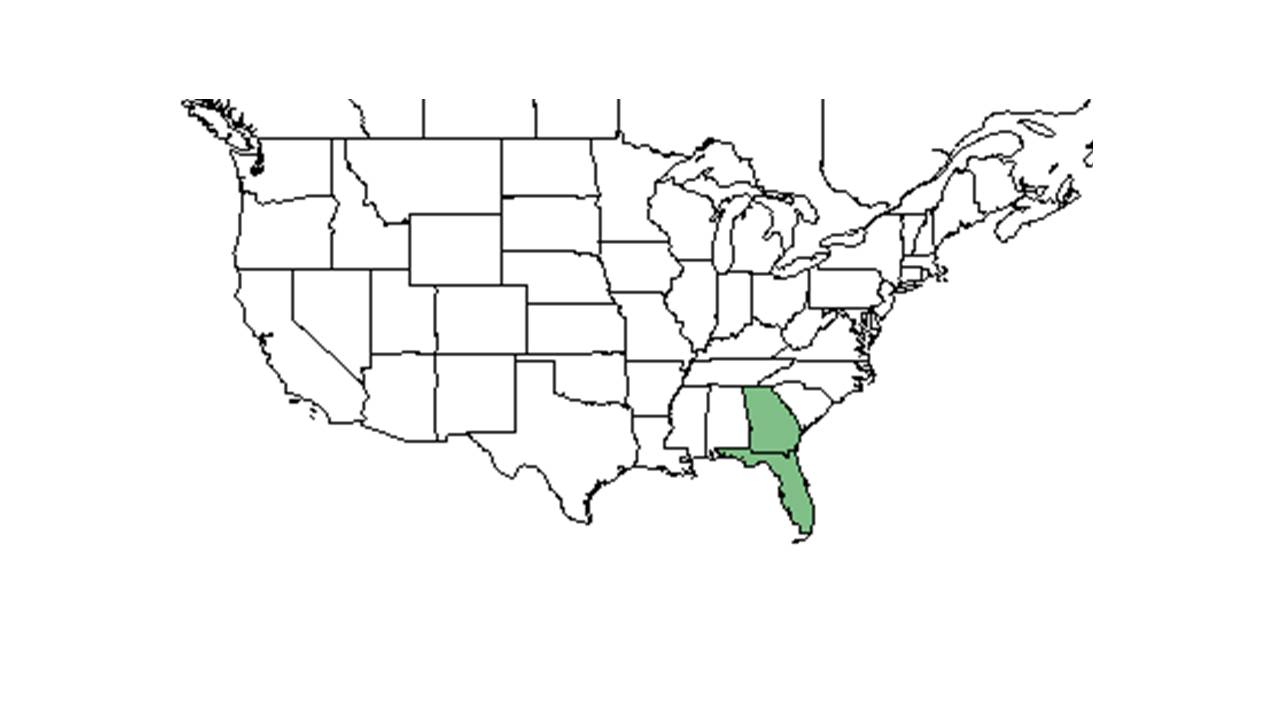Difference between revisions of "Baptisia lecontei"
KatieMccoy (talk | contribs) (→References and notes) |
KatieMccoy (talk | contribs) (→Seed dispersal) |
||
| Line 41: | Line 41: | ||
===Seed dispersal=== | ===Seed dispersal=== | ||
| − | ''Baptisia lecontei'' uses tumbleweed dispersal, a type of long-distance dispersal mechanism by which means the whole or a part of the plant serves to disperse seeds by being blown into the wind.<ref>Pijl 1972 cited by Mehlman 1993, more citation needed.</ref> Mehlman observe that ''B. lecontei'' could be found over 50 meters away from where it originated, evidently by wind dispersal <ref name="Mehlman 1993">Mehlman, D. (1993). "Tumbleweed dispersal in Florida sandhill Baptisia (Fabaceae)." Bulletin of the Torrey Botanical Club 120: 60-63.</ref>. Other dispersal mechanisms include movement in heavy rainstorms, Florida Harvester Ants, and if rooted, the seeds fall to the ground. Legume pods dehisce to release seeds | + | ''Baptisia lecontei'' uses tumbleweed dispersal, a type of long-distance dispersal mechanism by which means the whole or a part of the plant serves to disperse seeds by being blown into the wind.<ref>Pijl 1972 cited by Mehlman 1993, more citation needed.</ref> Mehlman observe that ''B. lecontei'' could be found over 50 meters away from where it originated, evidently by wind dispersal <ref name="Mehlman 1993">Mehlman, D. (1993). "Tumbleweed dispersal in Florida sandhill Baptisia (Fabaceae)." Bulletin of the Torrey Botanical Club 120: 60-63.</ref>. Other dispersal mechanisms include movement in heavy rainstorms, Florida Harvester Ants, and if rooted, the seeds fall to the ground. Legume pods dehisce vertically to release seeds. |
<!--===Seed bank and germination===--> | <!--===Seed bank and germination===--> | ||
<!--===Fire ecology===--><!--Fire tolerance, fire dependence, adaptive fire responses--> | <!--===Fire ecology===--><!--Fire tolerance, fire dependence, adaptive fire responses--> | ||
Revision as of 15:20, 4 April 2016
| Baptisia lecontei | |
|---|---|

| |
| Photo by John R. Gwaltney, Southeastern Flora.com | |
| Scientific classification | |
| Kingdom: | Plantae |
| Division: | Magnoliophyta - Flowering plants |
| Class: | Magnoliopsida - Dicotyledons |
| Order: | Fabales |
| Family: | Fabaceae ⁄ Leguminosae |
| Genus: | Baptisia |
| Species: | B. lecontei |
| Binomial name | |
| Baptisia lecontei Torr. & A. Gray | |

| |
| Natural range of Baptisia lecontei from USDA NRCS Plants Database. | |
Common Name: pineland wild indigo
Contents
Taxonomic notes
he genus name comes from the Greek word "bapto" meaning to dye[1].
Description
Baptisia lecontei is a bushy herb from a solitary stem, with knotty roots[2].
Perennial, Herbs, Stems woody below, or from woody crown or caudex, Plants with rhizomes or suckers, Nodules present, Stems erect or ascending, Stems less than 1 m tall, Stems solid, Stems or young twigs glabrous or sparsely glabrate, Stems or young twigs sparsely to densely hairy, Leaves alternate, Leaves petiolate, Stipules green, triangulate to lanceolate or foliaceous, Stipules persistent, Stipules free, Leaves compound, Leaves palmately 2-3 foliate, Leaf or leaflet margins entire, Leaflets 3, Leaves glabrous or nearly so, Inflorescences racemes, Inflorescence axillary, Inflorescence terminal, Bracts conspicuously present, Bracteoles present, Flowers zygomorphic, Calyx 5-lobed, Calyx hairy, Petals separate, Corolla papilionaceous, Petals clawed, Petals orange or yellow, Banner petal ovoid or obovate, Banner petal suborbicular, broadly rounded, Wing petals narrow, oblanceolate to oblong, Wing petals auriculate, Wing tips obtuse or rounded, Keel petals auriculate, spu rred, or gibbous, Keel tips obtuse or rounded, not beaked, Stamens 9-10, Stamens completely free, separate, Filaments glabrous, Style terete, Style persistent in fruit, Fruit a legume, Fruit stipitate, Fruit unilocular, Fruit freely dehiscent, Fruit tardily or weakly dehiscent, Fruit elongate, straight, Fruit oblong or ellipsoidal, Fruit orbicular to subglobose, Fruit or valves persistent on stem, Fruit coriaceous or becoming woody, Fruit exserted from calyx, Fruit inflated or turgid, Fruit beaked, Fruit hairy, Fruit 11-many seeded, Seeds reniform, Seed surface smooth, Seed surface with resinous dots, Seeds olive, brown, or black[3].
Distribution
B. lecontei occurs throughout the northern two-thirds of Florida and in some counties in Georgia[4].
Ecology
Habitat
B. lecontei requires open areas and strong, consistent winds for seed dispersal.[5] It also prefers higher light levels and moist to dry sandy soils like loamy sand and loose sand. It is found in longleaf pine-oak sandhill communities, shrub oak ridges, and pine flatwoods. However, it can also be found in certain disturbed habitats such as power line corridors, roadsides, railways, and cleared areas[2].
Associated species include Pinus palutris, Cuthbertia rosea, Quercus laevis, Q. marilandica, Q. geminata, Q. falcata, Q. incana, Prunus serotina, P. umbellata, Disopyros virginiana, RHus copallina, Vaccinium arboreum, V. stamineum, Rubus cunefolius, and others[2].
Phenology
The fruit is a membranous to ligneous legume[6]. This species has been observed flowering from April through July, and fruiting from June through August[2].
Seed dispersal
Baptisia lecontei uses tumbleweed dispersal, a type of long-distance dispersal mechanism by which means the whole or a part of the plant serves to disperse seeds by being blown into the wind.[7] Mehlman observe that B. lecontei could be found over 50 meters away from where it originated, evidently by wind dispersal [5]. Other dispersal mechanisms include movement in heavy rainstorms, Florida Harvester Ants, and if rooted, the seeds fall to the ground. Legume pods dehisce vertically to release seeds.
Conservation and Management
Cultivation and restoration
Photo Gallery
References and notes
- ↑ [[1]] Missouri Botanical Gardens. Accessed: April 4, 2016
- ↑ 2.0 2.1 2.2 2.3 Florida State University Robert K. Godfrey Herbarium database. URL: http://herbarium.bio.fsu.edu. Last accessed: June 2014. Collectors: Loran C. Anderson, R.K. Godfrey, Richard D. Houk, John K. Small, George R. Cooley, Leonard J. Brass, Robert Kral, Mabel Kral, Walter S. Judd, Paul Kalaz, Steve L. Orzell, Edwin L. Bridges, S. W. Leonard, Allen G. Shuey, A. H. Curtiss, Grady W. Reinert, W. Wilson Baker, Richard D. Houk, and A. F. Clewell. States and Counties: Florida: Wakulla, Suwannee, Clay, Columbia, Bay, Gilchrist, Leon, Hernando, Marion, Franklin, Lake, De Soto, Duval, and Dixie. Georgia: Brantley, Brooks, Lowndes, and Lanier.
- ↑ [[2]]Encyclopedia of Life. Accessed: April 4, 2016
- ↑ [[3]]Native Florida Wildflowers. Accessed: April 4, 2016
- ↑ 5.0 5.1 Mehlman, D. (1993). "Tumbleweed dispersal in Florida sandhill Baptisia (Fabaceae)." Bulletin of the Torrey Botanical Club 120: 60-63.
- ↑ Mehlman, D. W. (1993). "Tumbleweed Dispersal in Florida Sandhill Baptisia (Fabaceae)." Bulletin of the Torrey Botanical Club 120(1): 60-63.
- ↑ Pijl 1972 cited by Mehlman 1993, more citation needed.